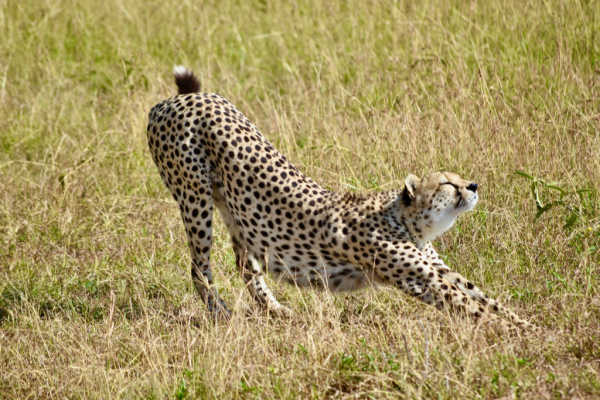Stretching the arms above the head body language gesture is often accompanied by yawning i.e., stretching facial muscles whilst opening the mouth. And accompanied by deep, slow inhalation followed by quick exhalation.
Yawning and stretching arms can occur independently, but when they occur together, the gesture is called pandiculation.

Pandiculation is an involuntary gesture where a person stretches one or both arms above or to the side of their head. The stretch can also be felt in the upper back region.
This gesture can be done sitting or standing. The fingers may or may not be interlaced. The elbows may or may not be bent. Sometimes the person doing this gesture will also stretch their neck by lifting their chin and touch the back of their neck.
When done standing, the gesture sends a wave of tension and relaxation throughout the body, and the person lifts their heels for a moment.
Stretching the arms above the head and yawning can sometimes be accompanied by a brief closure of the eyes. Sometimes, the torso may be twisted from side to side.
All vertebrates are known to pandiculate rather similarly. Dogs and cats do it multiple times a day. Horses, lions, tigers, leopards, birds, fish, all do it.

This shows that pandiculation is an evolutionarily old behavior that has been retained in us since the earliest vertebrates.1
Human babies innately do it. Even the human fetus does this gesture in the womb at about 12 weeks after conception.2
Note that voluntary stretching before a workout session or yoga is not pandiculation. Pandiculation is involuntary and controlled by the older, more instinctual parts of the brain.
When do we stretch our arms above our heads?
This gesture may be done when we wake up in the morning and when we’re about to sleep. Yawning is more common than stretching your arms when you’re about to sleep, and, in a moment, you’ll learn why.
Usually, this gesture is done after a long period of physical inactivity. For example, you might catch yourself doing it after you’ve been sitting in one spot for long.
Sleep, of course, is also a long period of physical inactivity.
Why do we pandiculate? The physiological angle
When you sleep or sit in one place for a long time, your muscles sort of get used to not moving. Stretching is the body’s way to get your muscles ready to move again. It sends a cascade of signals to the brain’s muscle control center, re-forging connections between the sensory and motor control areas.
In animals too, pandiculation has been observed to occur during transitions from periods of low to high activity.
This gesture relieves any tightness or constrictions in the muscles, reducing the chances of pain, injury, or spasms.
Psychological reasons for stretching and yawning
We can also do stretching and yawning to relieve psychological stress. Stretching feels good, and people often feel refreshed after a stretching and yawning session.
Why exactly we yawn is somewhat of a mystery. Still, there are some good explanations that make sense.
The explanation that makes the most sense is that yawning allows the brain to switch from inattentional or resting state (not paying attention) to an attentional state (being alert).3
In other words, yawning is a way your brain tries to get back online. It’s an attempt to pay attention after a period of inattention.
While stretching is a way to wake up your body, yawning is a way to wake up your brain. When you need to wake up both your body and brain, you may stretch as well as yawn.
This explains why we yawn when we wake up in the morning. We’re trying to bring our brain back online after a long period of unconsciousness so we can attend to our environment.
It also explains why we yawn when we’re about to sleep.
Yawning before sleeping is a way to maintain attention on the task at hand. The frequency of yawning before sleep increases when we’re putting off sleep to focus on something.
On one hand, your brain and body are tired and want rest. On the other, you want your brain to focus on your work or studying. The conflict leads to continual yawning- the brain’s attempt to keep you alert despite not wanting to.
Finally, when we’re disinterested, it’s hard to pay attention. We yawn when we’re bored so we can forcefully pay attention to what we don’t want to pay attention to.
Yawning and stretching, despite occurring together often, may happen for different reasons.
Say you’re speaking at a conference. When you finish your hour-long presentation, you notice that some audience members stretch their arms, some yawn, and some do both.
It’s tempting to think they found your speech boring. However, having gone through this article, you can’t jump to that conclusion so easily.
Stretching, with or without yawning, likely happened because they had to sit in one place for a long time.
Yawning, especially yawning without stretching, may show they’re tired mentally or sleepy or bored.
Hence, boredom is just one possibility out of many.
References
- Fraser, A. F. (1989). Pandiculation: the comparative phenomenon of systematic stretching. Applied Animal Behaviour Science, 23(3), 263-268.
- De Vries, J. I., Visser, G. H., & Prechtl, H. F. (1982). The emergence of fetal behaviour. I. Qualitative aspects. Early human development, 7(4), 301-322.
- Walusinski, O. (2014). How yawning switches the default‐mode network to the attentional network by activating the cerebrospinal fluid flow. Clinical Anatomy, 27(2), 201-209.
